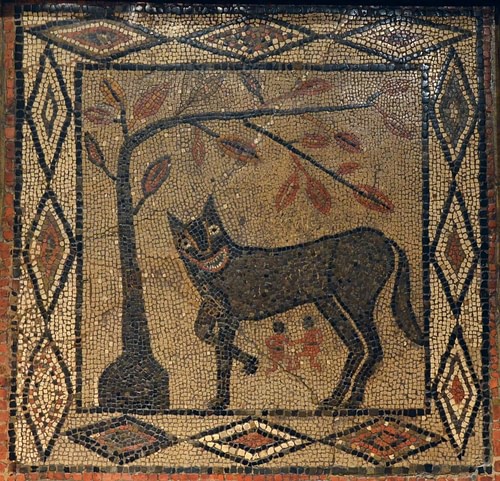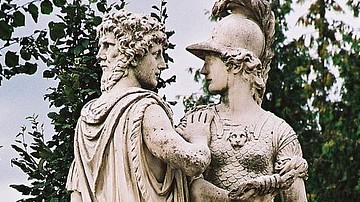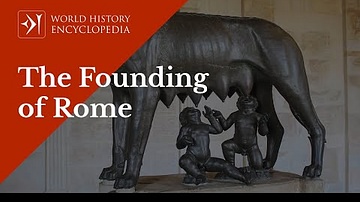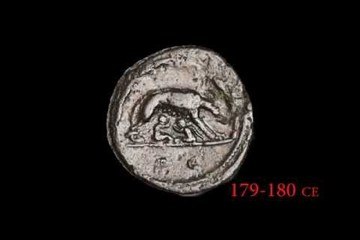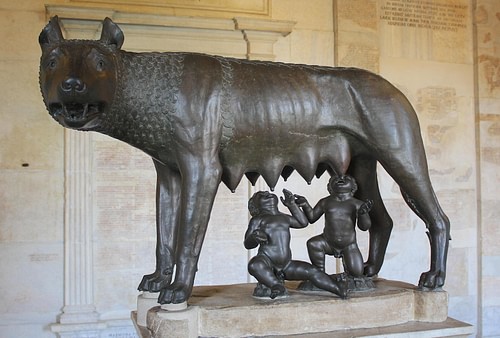
In Roman mythology, Romulus and his twin brother Remus were the founders of the city of Rome. They were the children of Rhea Silvia and Mars (or in some variations the demi-god hero Hercules) and their story is recorded by many authors including Virgil who claims their birth and adventures were fated in order for Rome to be founded.
The Birth & Parentage of Romulus & Remus
Romulus and Remus were the direct descendants of Aeneas, whose fate-driven adventures to discover Italy are described by Virgil in The Aeneid. Romulus and Remus were related to Aeneas through their mother's father, Numitor. Numitor was a king of Alba Longa, an ancient city of Latium in central Italy, and father to Rhea Silvia. Before Romulus' and Remus' conception, Numitor's reign was usurped by Numitor's younger brother, Amulius. Amulius inherited control over Alba Longa's treasury with which he was able to dethrone Numitor and become king. Amulius, wishing to avoid any conflict of power, killed Numitor's male heirs and forced Rhea Silvia to become a Vestal Virgin. Vestal Virgins were priestesses of Vesta, patron goddess of the hearth; they were charged with keeping a sacred fire that was never to be extinguished and to take vows of chastity.
There is much debate and variation as to whom was the father of Romulus and Remus. Some myths claim that Mars appeared and lay with Rhea Silvia; other myths attest that the demi-god hero Hercules was her partner. However, the author Livy claims that Rhea Silvia was in fact raped by an unknown man, but blamed her pregnancy on divine conception. In either case, Rhea Silvia was discovered to be pregnant and gave birth to her sons. It was custom that any Vestal Virgin betraying her vows of celibacy was condemned to death; the most common death sentence was to be buried alive. However, King Amulius, fearing the wrath of the paternal god (Mars or Hercules) did not wish to directly stain his hands with the mother's and children's blood. So, King Amulius imprisoned Rhea Silvia and ordered the twins' death by means of live burial, exposure, or being thrown into the Tiber River. He reasoned that if the twins were to die not by the sword but by the elements, he and his city would be saved from punishment by the gods. He ordered a servant to carry out the death sentence, but in every scenario of this myth, the servant takes pity on the twins and spares their lives. The servant, then, places the twins into a basket onto the River Tiber, and the river carries the boys to safety.
The Discovery of Romulus & Remus
The river god Tibernus ensured their safety by calming the river, and he caused their basket to catch in the roots of a nearby fig tree. The tree was located at the base of the Palatine Hill in the Velabrum swamp. The twins were first discovered by a she-wolf or lupa, who suckled them and they were fed by a woodpecker or picus. Eventually, they were discovered and cared for by a shepherd and his wife: Faustulus and Acca Larentia. The two boys grew up to be shepherds like their adoptive father. One day while they were herding their sheep, they were met by shepherds of King Amulius. These shepherds started a fight with Romulus and Remus in which Remus was captured and taken before King Amulius. Romulus gathered and incited a band of local shepherds to join him in rescuing his brother. King Amulius believed that Rhea Silvia's children were dead; he did not recognize Remus or Romulus. Romulus freed his brother, and in the process killed King Amulius.
Romulus & Remus Argue
After Amulius' death, the brothers rejected the citizens' offer of the crown of Alba Longa and instead reinstated Numitor as king. They left Alba Longa seeking to found their own city, and each set out to find the best locale. The brothers quarrelled over the location of the foundation of their new city; Romulus wished to start the city on the Palatine Hill, while Remus wished to found it on the Aventine Hill. In order to settle their disagreement, they agreed to consult augury; augury is a type of prophecy in which birds are examined and observed to determine what actions or persons the gods favour. Each brother prepared a sacred space on their respective hills and began to watch for birds. Remus claimed to have seen six birds, while Romulus said he saw twelve birds. Romulus asserted that he was the clear winner by six birds, but Remus argued that since he saw his six birds first, he had won. The brothers remained at a standstill and continued to quarrel until Romulus began to dig trenches and build walls around his hill: the Palatine Hill.
Death of Remus & Founding of Rome
In response to Romulus' construction, Remus made continuous fun of the wall and his brother's city. Remus was so bold as to jump over Romulus' wall jestingly. In response to Remus' mockeries and for jumping over his wall, Romulus, angered by his brother's belittlement, killed him. There are several versions as to how Remus was killed on the day Rome was founded. In Livy's version, Remus simply died after jumping over Romulus' wall, which is thought to be a sign from the gods of Rome's power and fate. According to St. Jerome, Remus was killed for his mockery by one of Romulus' supporters, either Fabius or Celer, who killed Remus by throwing a spade at his head. Afterwards, Romulus mournfully buries his brother, bestowing upon him full funeral honours. However, most sources would convey that Romulus killed Remus. Remus' death and founding of Rome are dated by Livy to April 21st, 753 BCE.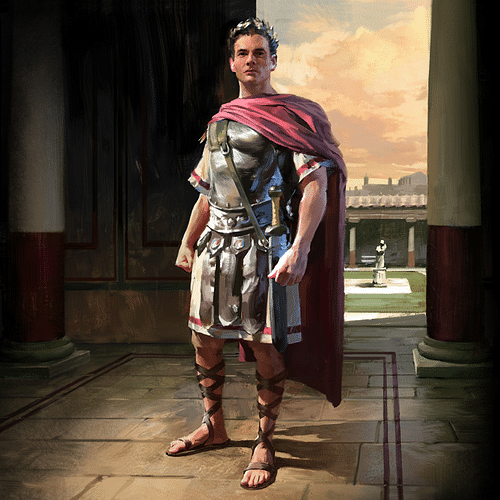
Beginnings of Rome: War & Peace
Romulus named his city Roma after himself. Following the foundation of his city, Romulus instated a government system that implemented senators and patricians. As the popularity of his city and government system grew, so did the population. Rome's initial population was supplied by fugitives, exiles, runaway slaves, and criminals and other castoffs. Due to the inflation of the male population, Rome was unable to produce any generations of their own. As a result of the low ratio of women to men, the newly Roman men decided to abduct women from a neighbouring city. They invited the Sabines and Latins to a festival of Cronus at the Circus Maximus, and while the men of these cities were distracted, the Roman men carried off their women into Rome. Many of these women were persuaded to marry; however, in response to this rape or abduction of women, the Sabine and Latin men went to war against Rome. Romulus was the definitive winner of this war and his victory was Rome's first triumph.
Although defeated, the Sabine king, Titus Tatius, attempted to assault Rome by marching on the Capitoline citadel. The citadel's commander's daughter promised to open the gates for the Sabine army if they gave her whatever "they bore on their left hand." When the Sabine army passed through, the poor girl expected hundreds of golden bracelets, but unfortunately she was crushed to death by their large shields. The Sabines besieged the Romans and the Romans almost lost until Romulus prayed to Jupiter for help. Jupiter answered, aiding the Romans to a final victory. Eventually, a truce formed between the Romans and Sabines along with Tatius and Romulus agreeing to form a joint reign of two kings. They jointly ruled for five years, and integrated each other's customs from calendars, gods, and even military tactics. This was a time of peace within Rome, but this intercity harmony ceased due to Tatius' actions. After these prosperous five years, Tatius was caught sheltering some of his allies who had robbed the neighbouring allied Lavinians and murdered some of their ambassadors. The Senate decided that Tatius must go to Lavinium to sacrifice and appease both the locals and god in regards to his crimes. While in Lavinium, Tatius was assassinated and Romulus became the sole king of Rome. For the next 20 years, Romulus sought to expand Rome's land through war. When Numitor died, Romulus incorporated Alba Longa into Rome's government and lands. Through Romulus' reign, he slowly became more autocratic and the Senate became resentful.
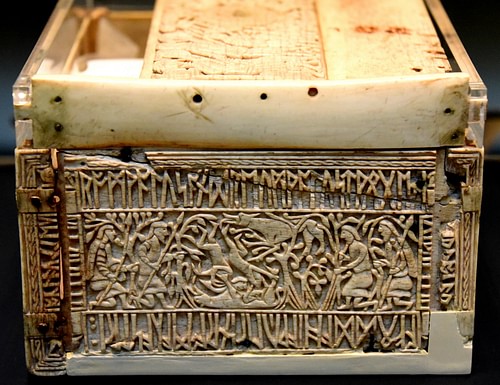
Death of Romulus
The life of Romulus has several endings depending on the myth and source. In one myth, Romulus mysteriously disappeared in a storm or whirlwind. Romulus is claimed to have ascended to the heavens to become a god by several eye-witnesses. There was the suspicion that Romulus' death was plotted by the Senate in order to reassume their own power. Livy writes about these events, while Cassius Dio writes about how Romulus was surrounded by hostile, resentful senators who "rent limb from limb" the senate-house, which was then followed by an eclipse and sudden storm (which Dio claims to be the same phenomenon that happened at his birth). Romulus disappeared in 717 BCE as reported by Plutarch at the age of 53, but Dionysius of Halicarnassus reports that he died at the age of 55.
A Man or myth?
There is much debate on whether Romulus and Remus were real men or simply a myth or even a combination of both. While most scholars believe that Aeneas, the catalyst of the foundation of Rome, may have existed in some folktale, his Roman mythology was not solidified until Augustus commissioned Vergil's epic The Aeneid. Romulus' and Remus' feats and adventures are somewhat far-fetched to be taken literally, but some scholars attest that their characters may be based on some historic foundation. Foundation myths are often convoluted with aspects of fiction and non-fiction. While it may never be certain if these twin brothers were real, what is certain is that their story was treated with respect and discussed at length even by the ancients.
Depiction in Art
Romulus and Remus are most commonly portrayed together in art and on coins. They are often only seen in art as infants being suckled by the she-wolf. They are featured in this manner on the statue of Romulus and Remus in Siena, Italy. Siena was founded, according to myth, by Remus' son, Senius. Likewise, they are also featured on a mosaic found in Yorkshire from 300 CE known as the Wolf Mosaic. However, the most famous representation in art is the Capitoline She-Wolf. It is a 5th century BCE Etruscan bronze wolf to which two small figures of Romulus and Remus were added in 15th century CE. Romulus' and Remus' mythical lives also inspired many Renaissance artists from Berrettini to LaFosse to Cesari, and even Rubens.
